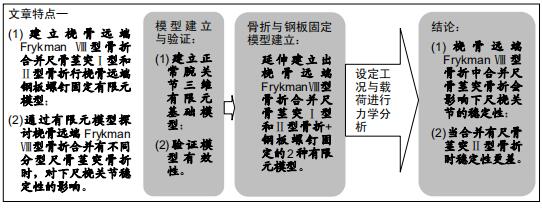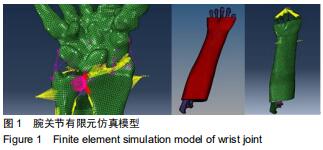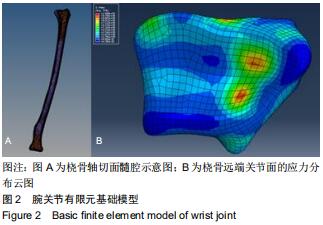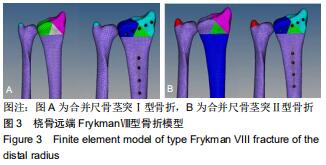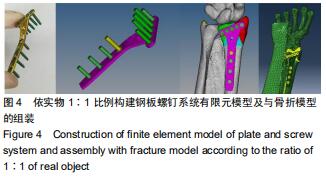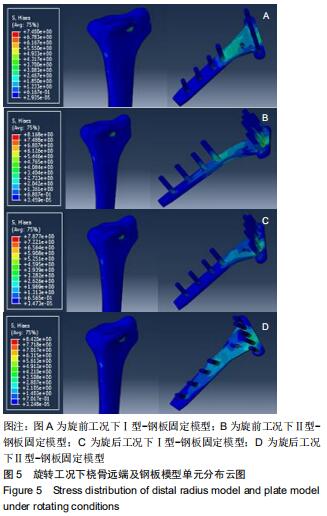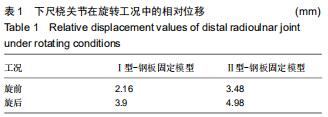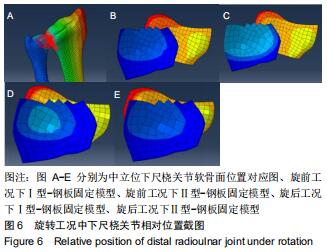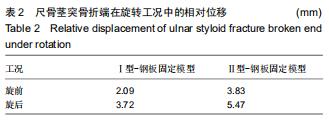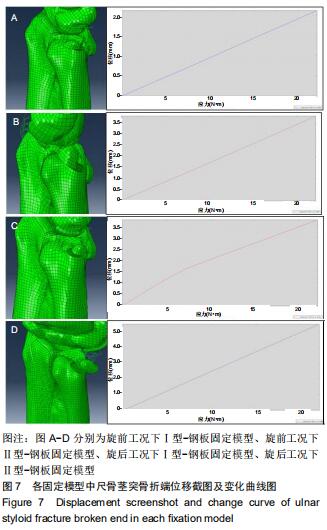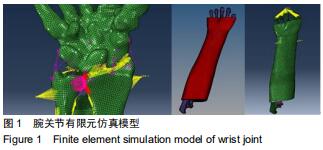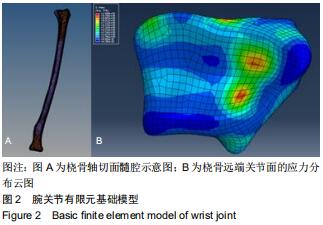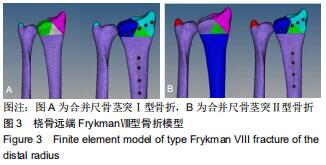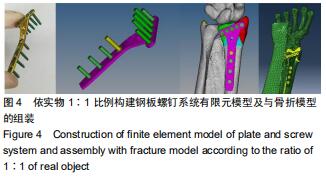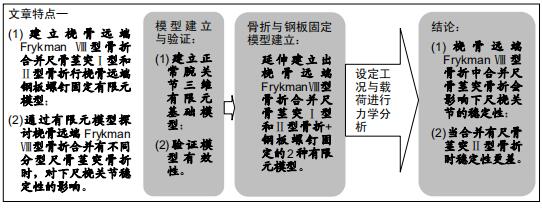|
[1] WILLIS AA, KUTSUMI K, ZOBITZ ME, et al. Internal fixation of dorsally displaced fractures of the distal part of the radius.A biomechanical analysis of volar plate fracture stability. J Bone Joint Surg Am. 2006;88(11):2411-2417.
[2] 徐春归,张积森,许新忠,等.合并尺骨茎突骨折对桡骨远端骨折钢板内固定术后功能恢复的影响[J].临床骨科杂志,2019,22(4): 466-470.
[3] 颜勇卿,张培训,王天兵,等.钢板内固定治疗桡骨远端骨折时是否合并尺骨茎突骨折对预后的影响[J].北京医学,2014,36(10): 822-824.
[4] MULDERS MAM, FUHRI SNETHLAGE LJ, DE MUINCK KEIZER RJO, et al. Functional outcomes of distal radius fractures with and without ulnar styloid fractures: a meta-analysis. J Hand Surg Eur. 2018;43(2):150-157.
[5] 曾卡斌,潘俊晖,吴天旺.尺骨茎突骨折类型对桡骨远端骨折治疗效果的影响[J].中国骨与关节损伤杂志,2018,33(1):88-89.
[6] 张光辉.桡骨远端骨折合并的尺骨茎突骨折内固定与否对腕关节功能的影响[J].临床医药文献电子杂志,2016,3(41): 8162-8164.
[7] 李永耀,程灏,赵勇,等.夹板固定治疗尺骨茎突骨折的三维有限元分析[J].中国组织工程研究,2018,22(11):1737-1742.
[8] 钦斌,黄永火,欧阳羽,等.轴向应力作用下的舟骨有限元分析[J].第三军医大学学报,2010,15(11):1213-1215.
[9] 徐振东,刘曦明,蔡贤华,等.LCP“动力化”一折端微动及应力的有限元分析[J].中国矫形外科杂志,2017,25(8):747-751.
[10] 尹峰,王晓东,梁炜,等.建立锁骨个性化锁定接骨板模型及有限元分析[J].中国组织工程研究,2016,20(35):5244-5249.
[11] SHORT WH, WERNER FW, FORTINO MD, et al. The stabilizing mechanism of the distal radioulnar joint during pronation and supination. J Hand Surg Am.1995;20(6): 930-936.
[12] KANG YK, PARK HC, YOUM Y, et al. Three dimensional shape reconstruction and finite element analysis of femur before and after the cementless type of total hip replacement. J Biomed Eng. 1993;15(6):497-504.
[13] LOTZ JC, CHEAL EJ, HAYES WC. Fracture Prediction for the proximal femur using finite element models:partl-linear analysis. J Biomech Eng.1991;11(2):353-360.
[14] 周建华,王跃.有限元分析在骨科中的应用及研究进展[J].实用医院临床杂志, 2018,15(1):205-208.
[15] 林蔚莘.斜T型钢板内固定治疗桡骨远端骨折的有限元分析[D].广州:南方医科大学,2004.
[16] 郭欣,樊瑜波,李宗明.掌骨受轴向压力作用下的腕部生物力学分析[J].航天医学与医学工程,2008,21(1):45-49.
[17] 魏成建,陶宝琛,张满臣,等.动力气囊压垫纠正桡骨远端AO C3.1型骨折残余侧方移位的三维有限元分析[J].医用生物力学,2018, 33(1):13-17.
[18] 陶宝琛,魏成建,白杨.三维有限元分析在桡骨远端骨折中的应用进展[J].山东中医杂志,2016,35(7):659-662.
[19] CILLA M, CHECA S, PREININGER B, et al. Femoral head necrosis: A finite element analysis of common and novel surgical techniques. Clin Biomech (Bristol, Avon). 2017;48(7): 49-56.
[20] WANG B, SUN P, XIE X,et al. A novel combined hemipelvic endoprosthesis for peri-acetabular tumours involving sacroiliac joint: a finite element study. Int Orthop. 2015;39(11): 2253-2259.
[21] HOSSEINI HS, DÜNKI A, FABECH J, et al. Fast estimation of Colles’ fracture load of the distal section of the radius by homogenized finite element analysis based on HR-pQCT. Bone. 2017;(1):97:65-75.
[22] TSUBONE T, TOBA N, TOMOKI U, et al. Prediction of fracture lines of the calcaneus using a three-dimensional finite element model. J Orthop Res. 2018; 37(2):483-489.
[23] OZASA Y, IBA K, OKI G, et al. Nonunion of the ulnar styloid associated with distal radius malunion.J Hand Surg Am. 2013;38(3):526-531.
[24] WIJFFELS MM, KEIZER J, BUIJZE GA, et al.Ulnar styloid process nonunion and outcome in patients with a distal radius fracture: A meta-analysis of comparative clinical trials. Injury. 2014;45(12):1889-1895.
[25] DAUMILLARE A, BOSCH C, JULIA M, et al. Volar locking plate fixation of distal radius fractures: Isokinetic assessment of the influence of an ulnar styloid process fracture on pronation-supination strength. Hand Surg Rehab. 2020;39(1): 23-29.
[26] CEREZAL L, DEL PIÑAL F, ABASCAL F. MR imaging findings in ulnar-sided wrist impaction syndromes. Magn Reson Imaging Clin N Am. 2004;12(2):281-299.
[27] KRAMER S, MEYER H, O’LOUGHLIN PF, et al. The incidence of ulnocarpal complaints after distal radial fracture in relation to the fracture of the ulnar styloid. J Hand Surg Eur. 2013; 38(7): 710-717.
[28] GONG HS, CHO HE, KIM J, et al. Surgical treatment of acute distal radioulnar joint instability associated with distal radius fractures. J Hand Surg Eur. 2015;40(8):783-789.
[29] ZENKE Y, SAKAI A, OSHIGE T, et al. The effect of an associated ulnar styloid fracture on the outcome after fixation of a fracture of the distal radius. J Bone Joint Surg Br. 2009; 91(1):102-107.
[30] 张俊,厉国定,尹伟忠,等.尺骨茎突骨折与否及不同分型对桡骨远端骨折术后疗效的影响[J].中国骨与关节损伤杂志, 2019,34(3):321-323.
|
